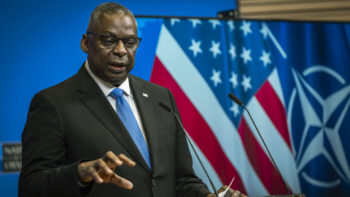Here’s a thought experiment. What if Vermont Senator Bernie Sanders becomes president? What would a Sanders defense program look like? Yes, yes, a near win in Iowa does not a presidential nominee make. Even though he’ll probably win in his neighboring state of New Hampshire, there is a long slog to the convention. Then there is the matter of the general election. But it is worth looking at what he might mean for defense.
First, the defense budget would be much, much smaller. All his new social programs, whatever their merits, must be paid for. Higher taxes could cover part of the cost, but inevitably other budget elements get squeezed. How much? In the first democratic debate, Sanders made approving references to the social programs of Scandinavian countries such as Norway, Denmark, and Sweden. They spend about 1.3% of GDP on defense (about the European NATO average). The United States in 2016 is spending 3.1 percent of GDP on defense (excluding war funding). Slicing that to 1.3 percent of GDP would produce a DoD budget of about $235 billion, still the largest military budget in the world but less than half of today’s $535 billion. While Sanders has never made such a proposal, his concept for the role of government pushes in this direction. So let’s consider what such a budget could buy and what trade-offs would be required.
Running such a budget through the CSIS Force Cost model produces some interesting results. Essentially, forces would be cut by about 60 percent and acquisition programs would have to be radically restructured. Such a budget cannot support the defense establishment that has existed since the Second World War. Nor can it execute the kind of global strategy that Americans have taken for granted, whatever the ups and downs of defense spending have been. But let’s focus here on the immediate budget and programmatic implications.
Sanders argues forcefully for eliminating “waste, fraud, and abuse” in the Pentagon. He is not alone. Many members of the Congress, left and right, see the same problem. However, structuring processes and programs to make them more efficient is hard. Cutting defense waste is the national security equivalent of eliminating “welfare queens”—yes, the phenomenon exists; yes, government should take aggressive action against it; no, it’s not going to produce a lot of savings. To save real money you have to cut people and programs.
Sanders first target would be nuclear forces. He has repeatedly argued that they are too expensive and pledged to cut $100 billion in nuclear spending over 10 years. Sanders would likely embrace a doctrine called “minimum deterrence”; that is, maintaining only enough nuclear capability to threaten devastating retaliation. Although force definitions for minimum deterrence vary, 300 to 400 warheads is a rough estimate. That compares with the current New START cap of 1550. Getting down to that level would require retiring the entire ICBM force, retiring the nuclear bomber force, and reducing the sea-based leg to about six submarines from the current 14. The new Long Range Strike Bomber program (LRSB) would be terminated because of its high cost, even though its primary mission is conventional. There would be commensurate reductions in the National Nuclear Security Administration, which develops and produces nuclear weapons. One of the weapons labs, likely Lawrence Livermore in California, would have to be shuttered. All this would save real money, about $15 billion per year, but not nearly enough.
Sanders has also been critical of national missile defense, so one would expect radical reductions there. But potential savings are not that large. The budget of the Missile Defense Agency is $8.1 billion, of which about half is for national missile defense and the other half is for theater missile defense. Programs in theater missile defense, such as THAAD, AEGIS SM-3, and PATRIOT have had much more successful testing records than the national missile defense programs. Because theater programs defend US forces overseas and our allies, they have also had bipartisan political support. So there might be savings of $1 billion to $2 billion per year but, again, not nearly enough to close the gap.
Here’s what you would need to do to produce the savings needed.
- Reduce the active Army to about 250,000 soldiers, down from today’s level of 475,000. To compensate, the reserves might be reduced less, to perhaps 290,000 for the National Guard and the Army Reserve. This would be consistent with Sander’s statements that he wants to decrease America’s overseas presence, particularly in wealthy regions like Europe and Japan. The Army would become a surge force rather than a forward-deployed force. Its capability would still be formidable, perhaps 25 total combat brigades, but it would take much longer to get overseas. Think World War Two, not Desert Storm.
- Shrink the Navy to about 160 ships with maybe five carriers (“Cold War weapons”). It would take a long time to get to this level, even by retiring ships early. The Navy could live off its existing inventory for a decade or two. Nevertheless, the smaller fleet would over time mean a much reduced overseas presence. Even giving preference to the Pacific theater, withdrawing entirely from Europe and mostly from the Middle East, the Pacific rebalance would be radically scaled back. Countries in the Western Pacific would likely make their best deal with a rising China rather than relying on a withdrawing United States. To maintain any sort of shipbuilding industrial base, the Navy would need to continue to build a few ships, but some shipyards would still have to close. Based on recent history, NASCO in California and Bath Iron Works in Maine would certainly go out of business. So might the Electric Boat Company in Connecticut.
- Switch the Air Force from building fifth generation aircraft like the F-35 (“incredibly wasteful”) to extending the life of its fleet of legacy aircraft like F-16s and F-15s. The Air Force would still have a formidable fifth-generation force in the F-35’s already built and the existing F-22’s, although that force would be much smaller than planned.
- Reduce the Marine Corps to a strength of about 90,000 (active). It would still be the largest marine corps in the world but would not be able to maintain the forward deployments that have been customary since the Second World War.
There’s no question, the defense establishment would “feel the Bern.”
Mark Cancian, a former top defense budget analyst at the Office of Managment and Budget under President Obama, is a defense analyst at the Center for Strategic and International Studies.
This is the second in a series of periodic analyses we’ll run as the 2016 presidential campaigns mature and defense proposals become more specific. The Editor
Air Force’s legislative proposal is an existential threat to the National Guard
In this op-ed, Francis M. McGinn, the head of the National Guard Association, blasts an Air Force proposal to transfer National Guard units performing space missions to the Space Force.




























